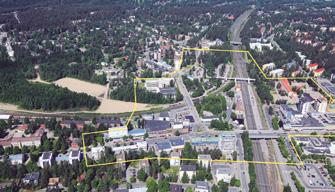ROTTERDAM BRAINPARK I (NL) PROJECT SCALE — L – urban + architecture
OWNER OF THE SITE — Public and private ownership
LOCATION — Rotterdam, Brainpark I
POST-COMPETITION PHASE — Design (or research-by-design)
POPULATION — 650,000 inhab.
assignment on implementation on the site
STRATEGIC SITE — 101.6 ha / PROJECT SITE — 17.9 ha
(or a site with similar characteristics) commissioned by the
SITE PROPOSED BY — Municipality of Rotterdam
Municipality of Rotterdam and/or private partners
Europan Nederland — 1. WHAT ARE THE GOALS OF THE SITE MUTATION?
Brainpark I is an isolated office area in eastern Rotterdam. It was built around the 1990s to accommodate spinouts of the adjacent Erasmus University, inspired by “productive parks” like MIT in Cambridge. Situated between the A16 motorway and Kralingse Zoom, an important regional public transport hub, it is easily accessible. It is in the vicinity of remarkably green public areas, powerful institutions and attractive neighbourhoods. It clearly has a high-potential profile. Nevertheless, it is currently characterized by rather traditional businesses with no link to the knowledge infrastructure, relatively small and some vacant buildings, and public space that lacks activity. The challenge is to develop a densification strategy that unlocks the productive potential of the site, setting the transformation in motion from a monofunctional business area along the motorway to a healthy, vital and interactive work-and-live milieu. 2. HOW CAN THE SITE BE INTEGRATED IN THE ISSUES OF PRODUCTIVE CITIES? HOW DO YOU CONSIDER THE PRODUCTIVITY ISSUE?
174
The City of Rotterdam seeks opportunities in the combination of accommodating its growth and boosting the next economy with vibrant places of interaction. For Brainpark I, there is a twofold spatial strategy. On the one hand, densifying the area with innovative work-home housing typologies, using the potential of the public transport hub and dealing with the challenging environmental issues on site (such as car noise and highway emissions). On the other, strengthening interaction milieus by creating high-quality public space and places to work and live, and more importantly by creating the right mix of functions. 3. HAVE YOU ALREADY DEFINED A SPECIFIC PROCESS FOR THE URBAN AND/OR ARCHITECTURAL DEVELOPMENT OF THE SITE AFTER EUROPAN COMPETITION?
Characteristic of Rotterdam is the credo “making city together”. Municipality, market parties, corporations and other enthusiastic city makers are working together to build a productive, inclusive, healthy, circular and compact city. In order to put their money where their mouth is, the parties involved are now trying to actually bring the rich harvest of Europan 15 one step closer to realization, together with the winning teams. To this end, a workshop programme is established, in which thinking and doing go hand in hand. First leading questions for Brainpark I: The most important challenge for this location is to provide it with a new identity. The mixed ownership and the risk of fragmented developments make this complex. The stakes are to create common interest. Good connections are an important condition for the development of Brainpark I as residential area. We aim for a small and quick intervention that can give a view on future quality and improve the connection with the surrounding areas.









































































